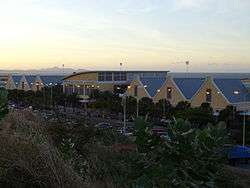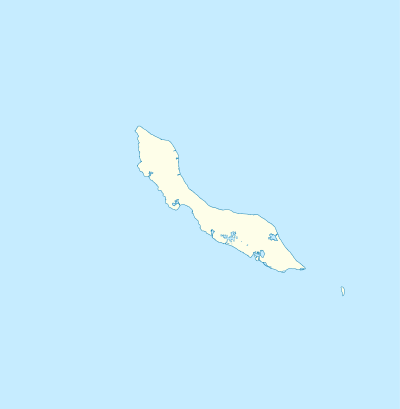Curaçao International Airport
| Curaçao International Airport Hato International Airport | |||||||||||
|---|---|---|---|---|---|---|---|---|---|---|---|
 | |||||||||||
| Summary | |||||||||||
| Airport type | Public | ||||||||||
| Owner | Curaçao Airport Holding | ||||||||||
| Operator | Curaçao Airport Partners | ||||||||||
| Serves | Curaçao | ||||||||||
| Location | Willemstad, Curaçao | ||||||||||
| Hub for | |||||||||||
| Elevation AMSL | 29 ft / 9 m | ||||||||||
| Coordinates | 12°11′20″N 068°57′35″W / 12.18889°N 68.95972°WCoordinates: 12°11′20″N 068°57′35″W / 12.18889°N 68.95972°W | ||||||||||
| Website | curacao-airport.com | ||||||||||
| Map | |||||||||||
 CUR Location in Curaçao | |||||||||||
| Runways | |||||||||||
| |||||||||||
| Statistics (2015) | |||||||||||
| |||||||||||
Curaçao International Airport (IATA: CUR, ICAO: TNCC), also known as Hato International Airport (formerly Dr. Albert Plesman International Airport), is the airport of Willemstad, Curaçao. It has services to the Caribbean region, South America, North America and Europe. Hato Airport is located on the north coast of Curaçao, 12 kilometres from Willemstad, which is a fairly large facility, with the third longest commercial runway in the Caribbean region after Rafael Hernández Airport in Puerto Rico and Pointe-à-Pitre International Airport in Guadeloupe. The airport serves as a main base for Insel Air and Divi Divi Air. It used to serve as a main base for ALM, KLM, DCA and DAE.
History

The airport was initially called Hato Airport, namesake to the nearby town of Hato. On Tuesday, 5 January 1954, the airport was renamed Dr. Albert Plesman airport. Plesman, director of the Royal Dutch Airlines for the Netherlands and Colonies, had died a few days earlier. Often it was spoken of Aeropuerto Plesman or Plesman Airport, unofficially also the name Hato remained in use till this day. Nowadays the official name is: Curaçao International Airport.
'It will be unnecessary to set out in detail, of which it is of paramount importance, that the Dutch aviation industry gets a firm footing in the vicinity of the Caribbean sea, where air traffic is now becoming more and more a factor of economic significance.' - Albert Plesman With above argument in March 1934 Albert Plesman, director of KLM, hoped to receive financial support from the Comité Vliegtocht Nederland-Indië. It was a new plan to head to the West. In the 1920s it started to interest itself in the Caribbean region. Curaçao was developing itself in a beneficial way due to the presence of the oil refinery and a growing number of people were starting to choose the region with the purpose of vacationing. Aviation companies were paying close attention to these developments and were researching if it was possible to create a connection between the United States, Curaçao and South America. The West Indische Gouvernement constructed a runway at the Hato plantation in Curaçao,

On 22 December 1934 the Snip plane arrived in Curaçao after an 8th day during trip with the route Amsterdam-Marseille-Alicante-Casablanca-Porto Praia-Paramaribo-La Guaria-Curaçao.
Hato was one of the most important and busiest airports in the Caribbean during the Second World War. The airfield was used by the US Air Force for patrols against submarines.
During the 1960s the 'Bestuurscollege' commissioned Netherlands Airport Consultants B.V. (NACO) to design a Master plan for the airport. This assignment was in connection with the expected arrival of the Boeing 747. The 'Jumbo' first flew on 9 February 1969.
Curaçao International Airport N.V. (Curinta) was founded in 1977 and operated the Airport until 2013. Its predecessor was the 'Luchthavenbedrijf', which was a department of the Government of Curaçao.
World War II
During World War II, the airport was used by the United States Army Air Forces Sixth Air Force conducting antisubmarine patrols. Flying units using the airfield were:
- 59th Bombardment Squadron (VI Bomber Command) 10 March 1942 – 13 July 1943 (A-20 Havoc)
- 32d Fighter Squadron (36th Fighter Group, Antilles Air Command, XXVI Fighter Command) 9 March 1943 – 13 March 1944, (P-40 Warhawk)
- Detachment operated from: Dakota Field, Aruba, 9 March 1943 – 9 March 1944
- Detachment operated from: Losey Army Airfield, Puerto Rico, 9 March – 4 June 1944
- 25th Bombardment Group (VI Bomber Command), 1 August – 5 October 1943
Airlines and destinations
- Notes
- ^1 Insel Air's flights to Paramaribo and Sint Maarten are operated by Conviasa.
- ^2 KLM's flights operate from Amsterdam to Curaçao via Sint Maarten on selected days. However, the airline does not have fifth freedom rights to transport passengers solely between Sint Maarten and Curaçao. The flight continues on from Curaçao to Amsterdam directly.
- ^3 TUI fly Belgium's flights will operate from Brussels to Curaçao via Santo Domingo. However, the airline does not have fifth freedom rights to transport passengers solely between Santo Domingo and Curaçao. The flight continues on from Curaçao to Brussels directly.
- ^4 TUI fly Netherlands's flights operate between Aruba, Bonaire and Curaçao on selected days. However, the airline does not have fifth freedom rights to transport passengers solely between Aruba, Bonaire and Curaçao.
Cargo
Coast Guard Air Station Hato
Located at the west side of Hato Airport there are hangars for the two Bombardier Dash 8 Maritime Patrol Aircraft and two AgustaWestland AW139 helicopters of the Dutch Caribbean Coast Guard. This was until 2007 a naval airbase of the Royal Netherlands Navy who operated the base for 55 years. With a wide variety of aircraft in the past years Fireflies, Avengers, Trackers, Neptunes, Fokker F-27's, P-3C Orions, Fokker F-60's and several helicopters. After the political decision to sell all Orions the airbase wasn't needed anymore.
The west end of the airport is a USAF Forward Operating Base (FOB). The base hosts AWACS and transport aircraft. Until 1999 the USAF operated a small fleet of F-16 fighters from the FOB.
References
![]()
- ↑ Airport information for TNCC at World Aero Data. Data current as of October 2006.Source: DAFIF.
- ↑ Curaçao factsheet Archived 11 October 2016 at the Wayback Machine.. Zurich Airport.
- ↑ "Air Canada W18 Sun Destinations service changes as of 18JUN18". routesonline.com. Retrieved 19 June 2018.
- ↑ https://www.panrotas.com.br/aviacao/novas-rotas/2018/10/curaca-tera-voo-direto-de-sao-paulo-a-partir-de-dezembro_159382.html
External links
- Airport information for TNCC at Great Circle Mapper. Source: DAFIF (effective October 2006).
- Accident history for CUR at Aviation Safety Network
.jpg)